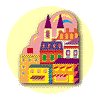









ANO SIMI
 Ano Simi or Horio is the capital of the island. It is built on ancient and Byzantine ruins, and, on its hilltop, the celebrated castle of the knights dominates the area and offers a breathtaking view of the sea. The tile roofs of the warm-colored houses with the lovely balconies create an enchanting picture.
The churches of the town attract visitors because of the black and white pebbles which pave the courtyards, the exquisite woodcut and carved screens inside and the historical manuscripts. The most important churches are Panagia Keharitomeni, Agios Dimitrios, Agios Athanasios and Timios Stavros.
The Archaeological Museum of Ano Simi is housed in an old mansion and includes Byzantine and post-Byzantine works of art, sculpted inscriptions and vessels.
Ano Simi or Horio is the capital of the island. It is built on ancient and Byzantine ruins, and, on its hilltop, the celebrated castle of the knights dominates the area and offers a breathtaking view of the sea. The tile roofs of the warm-colored houses with the lovely balconies create an enchanting picture.
The churches of the town attract visitors because of the black and white pebbles which pave the courtyards, the exquisite woodcut and carved screens inside and the historical manuscripts. The most important churches are Panagia Keharitomeni, Agios Dimitrios, Agios Athanasios and Timios Stavros.
The Archaeological Museum of Ano Simi is housed in an old mansion and includes Byzantine and post-Byzantine works of art, sculpted inscriptions and vessels.
 Gialos is a lovely settlement with mansions built on scarce vegetation. Next to the port stands the basilica-styled church of Agios Ioannis, which was built in 1836 on ancient or pre-christian ruins. Other noteworthy sites are the churches of Panagia Lemonitissa and Agia Elikoni, as well as the church of the Annunciation of the Virgin Mary in Harnani. This church was built in a Byzantine-style in 1914, and it contains a magnificent wood-carved screen, as well as significant paintings. One should also pay a visit to the clock tower which was built in 1880, the Nautical Museum, and the small dockyard, where the caiques of the island are made.
Gialos is a lovely settlement with mansions built on scarce vegetation. Next to the port stands the basilica-styled church of Agios Ioannis, which was built in 1836 on ancient or pre-christian ruins. Other noteworthy sites are the churches of Panagia Lemonitissa and Agia Elikoni, as well as the church of the Annunciation of the Virgin Mary in Harnani. This church was built in a Byzantine-style in 1914, and it contains a magnificent wood-carved screen, as well as significant paintings. One should also pay a visit to the clock tower which was built in 1880, the Nautical Museum, and the small dockyard, where the caiques of the island are made.
 This enchanting little settlement lies southeast of the island's capital. Built among pine-trees, it is probably the prettiest site on the island. It has been named after the patron saint of the island, Michail Panormitis. Apart from the monastery of the same name, one can also visit the beautiful area of Faneromeni and the monastery of the Savior.
This enchanting little settlement lies southeast of the island's capital. Built among pine-trees, it is probably the prettiest site on the island. It has been named after the patron saint of the island, Michail Panormitis. Apart from the monastery of the same name, one can also visit the beautiful area of Faneromeni and the monastery of the Savior.
 The picturesque settlement of Pedi is built at the mouth of a small natural port, 2 km east of Ano Simi. It is worth visiting the church of the Agia Triada and that of Agios Georgios, which used to be the island's cathedral. The inhabitants live on the cultivation of the surrounding area which abounds in pear, almond and olive trees. Their other source of income comes from their vineyards and tourism, which has grown considerably in recent years.
In neighbouring areas, excavations have brought to light scattered ancient Greek and Roman ruins as well as remains of an early christian basilica-style church. North of the port stands the picturesque chapel of Agios Thomas and the celebrated petrified forest, which is one on the most exquisite sites of the island.
The picturesque settlement of Pedi is built at the mouth of a small natural port, 2 km east of Ano Simi. It is worth visiting the church of the Agia Triada and that of Agios Georgios, which used to be the island's cathedral. The inhabitants live on the cultivation of the surrounding area which abounds in pear, almond and olive trees. Their other source of income comes from their vineyards and tourism, which has grown considerably in recent years.
In neighbouring areas, excavations have brought to light scattered ancient Greek and Roman ruins as well as remains of an early christian basilica-style church. North of the port stands the picturesque chapel of Agios Thomas and the celebrated petrified forest, which is one on the most exquisite sites of the island.
http://www.areianet.gr/infoxenios/
